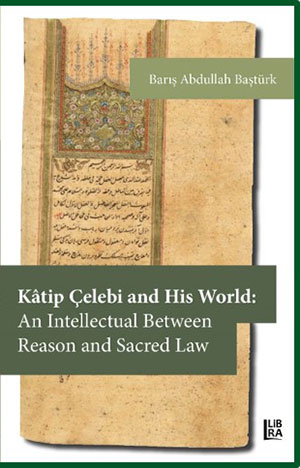
By using sources such as Mizan ül-Hak, Düstur ül-Amel, Tarih-i Kostantiniyye ve Kayasıre and Tarih-i Frengi Tercümesi, this book analyzes Kâtip Çelebi, one of the most prominent intellectuals of the 17th century. Kâtip Çelebi, who might be seen as a renaissance man, was an influential thinker who contributed to a variety of different fields including history, politics, naval warfare, society, philosophy, Islamic law, and many others.
This book aims to explore Kâtip Çelebi’s thoughts on 17th century crises, including his ideas on how to reform the Ottoman state structure. It discusses his ideas on society and authority which are grounded in reason and religious law simultaneously. This work suggests Kâtip Çelebi provided an authentic intellectual perspective that was critical of different sides in the above-mentioned debates and provided a moderate and balanced approach when analyzing various issues.
Künye
Kitabın Adı: |
Kâtip Çelebi and His World: An Intellectual Between Reason and Sacred Law |
Yazan: |
Barış Abdullah Baştürk |
Dizi Adı: |
History: 440 |
Yayın Yılı: |
2021 |
Sayfa: |
165 |
Ebat: |
13,5 x 21 cm. |
Kağıt: |
Enzo 70 gr. |
Kapak: |
Cevdet Mehmet Kösemen |
Cilt/Kapak: |
250 gr. Mat, Amerikan Bristol, 4 renk |
ISBN/Barkod: |
978-625-8472-11-0 |
İÇİNDEKİLER
ACKNOWLEDGEMENTS
NOTES ON TRANSLITERATION
INTRODUCTION: WHY STUDY KÂTİP ÇELEBİ
CHAPTER I
AN OTTOMAN INTELLECTUAL AT WORK: KÂTİP ÇELEBİ
1. Kâtip Çelebi’s Life
2. Kâtip Çelebi’s Works
2.1. Keşf-üz-Zünun
2.2. Fezleket’ül Akval ül-Ahyar
2.3. Takvim üt-Tevarih
2.4. Fezleke-i Tevarih
2.5. Cihannüma
2.6. Süllem ül-Vusül ila Tabakat ü’l-Füsul
2.7. Levami ün-Nur fi Zülmet-i Atlas Minur
2.8. Tarih-i Kostantiniye ve Kayasıre (Revnak’üs-Saltanat)
2.9. Tarih-i Frengi Tercümesi
2.10. Bahriye
2.11. Düstur ül-Amel fi Islah ül-Halel
2.12. İrşad ül-Hayara ila Tarih ül-Yunan ve’r Rum ve’n Nasara
2.13. Tuhfet ül-Kibar fi Esfar ül-Behar
2.14. Mizan ül-Hak fi İhtiyar ül-Ehak
2.15. İlham ül-Mukaddes
2.16. Cami ül-Mutun min Cel ül-Fünun
2.17. Tuhfet ül-Ahyar fi’l-Hikem ve’l-Emsal ve’l-Aşar
2.18. Dürer-i Muntesire ve Gurer-i Münteşire
3. Historiography of Kâtip Çelebi
CHAPTER II
SOCIETY, POLITICS AND KÂTİP ÇELEBİ
1. The Sources
1.1. Düstur ül-Amel
1.2. Ottoman Mirror for Princes or Nasihatname Literature
2. Elements of Society According to Kâtip Çelebi
2.1. Social Classes in Düstur ül-Amel
2.2. Kâtip Çelebi and Social Order
3. Social Problems and Crisis According to Kâtip Çelebi
3.1. Kâtip Çelebi and the 17th Century Crisis
3.2. Absolutists versus Constitutionalists
3.3. Kâtip Çelebi and Politics of his Age
3.4. Kâtip Çelebi and the Individual
4. Kâtip Çelebi’s Remedies
5. Kâtip Çelebi’s Ideal Society
5.1. Kâtip Çelebi and History
6. Summary of the Chapter
CHAPTER III
ISLAMIC LAW, LOGIC AND KÂTİP ÇELEBİ
1. The Sources
1.1. Mizan ül-Hak
2. Theological-Legal Debates and Kâtip Çelebi
2.1. The Social Issues within Perspectives of Law, Logic and Reason
2.2. Why Consult Kâtip Çelebi?
2.3. Kadızadeli versus Sufi Debate
2.4. Singing, Dancing and Whirling
2.5. Tobacco
2.6. Coffee, Opium and Drugs
2.7. Parents of the Prophet
2.8. The Faith of the Pharaoh
2.9. Ibn Arabi and Kâtip Çelebi
2.10. The Cursing of Yazid
2.11. Innovation
2.12. The Visiting of the Tombs
2.13. The Supererogatory Prayers
2.14. Shaking Hands and Bowing
2.15. Enjoining Right and Forbidding Wrong
2.16. The Religion of Abraham
2.17. Bribery
2.18. Kâtip Çelebi and the Controversies of the Age
2.19. The Recital of God’s Bounty or the Conclusion
2.20. İlham ül-Mukaddes
2.21. Kâtip Çelebi and Enlightenment, Science and Reason
2.22. Religion, Islamic Law and Kâtip Çelebi
2.23. Kâtip Çelebi and Philosophy
2.24. Kâtip Çelebi and Practical Knowledge
3. Summary of the Chapter
CHAPTER IV
A HISTORIAN AT WORK KÂTİP ÇELEBİ BETWEEN THE EAST AND THE WEST
1. A Discussion of the Sources
2. Tarih-i Kostantiniyye ve Kayasire
2.1. The Footnotes
2.2. The Problem of Ethnicity
2.3. History Writing and Kâtip Çelebi
2.4. Turks According to the Chronicle Tarih-i Kostantiniyye ve Kayasire
2.5. Geographic Regions in the Chronicle
3. Tarih-i Frengi Tercümesi
3.1. Perception of Turks According to Tarih-i Frengi Tercümesi
4. Summary of the Chapter
CONCLUSION
BIBLIOGRAPHY
INDEX

